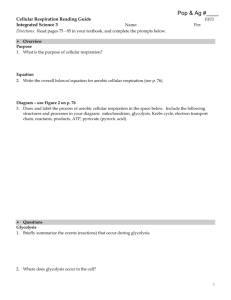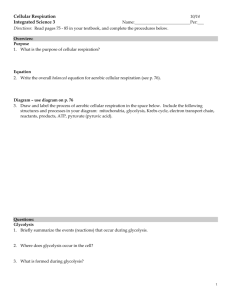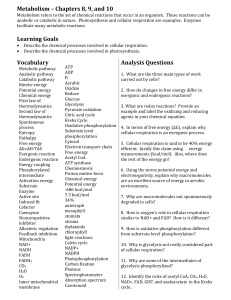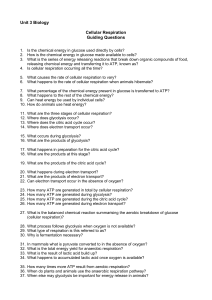6: Respiration Worksheet
advertisement
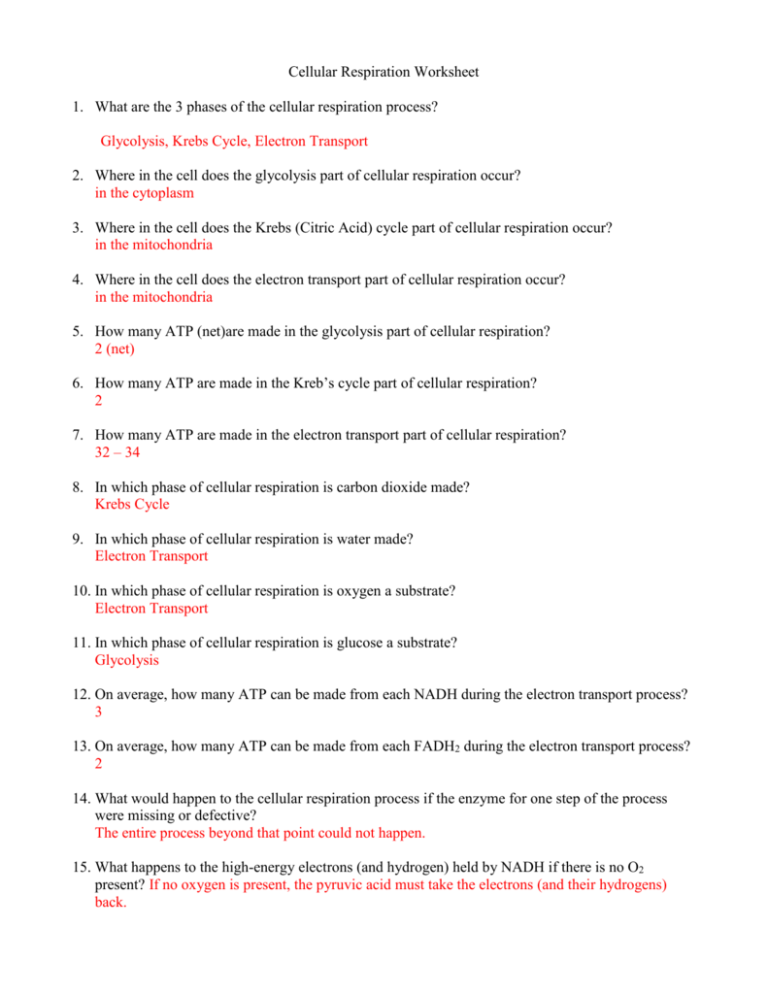
Cellular Respiration Worksheet 1. What are the 3 phases of the cellular respiration process? Glycolysis, Krebs Cycle, Electron Transport 2. Where in the cell does the glycolysis part of cellular respiration occur? in the cytoplasm 3. Where in the cell does the Krebs (Citric Acid) cycle part of cellular respiration occur? in the mitochondria 4. Where in the cell does the electron transport part of cellular respiration occur? in the mitochondria 5. How many ATP (net)are made in the glycolysis part of cellular respiration? 2 (net) 6. How many ATP are made in the Kreb’s cycle part of cellular respiration? 2 7. How many ATP are made in the electron transport part of cellular respiration? 32 – 34 8. In which phase of cellular respiration is carbon dioxide made? Krebs Cycle 9. In which phase of cellular respiration is water made? Electron Transport 10. In which phase of cellular respiration is oxygen a substrate? Electron Transport 11. In which phase of cellular respiration is glucose a substrate? Glycolysis 12. On average, how many ATP can be made from each NADH during the electron transport process? 3 13. On average, how many ATP can be made from each FADH2 during the electron transport process? 2 14. What would happen to the cellular respiration process if the enzyme for one step of the process were missing or defective? The entire process beyond that point could not happen. 15. What happens to the high-energy electrons (and hydrogen) held by NADH if there is no O2 present? If no oxygen is present, the pyruvic acid must take the electrons (and their hydrogens) back. 16. Explain why this happens. This happens because there are only a small number of NAD+ molecules in the cell. They must be reused to keep glycolysis going with additional glucose molecules. This means they need to “unload” the electrons from NADH by giving them to some other molecule. Since the pyruvic acid cannot continue on to the Krebs cycle when there is no oxygen present, it receives the electrons. This allows the glycolysis portion of cellular respiration to continue even when O2 is not present. This process of making ATP in the absence of O2 is called fermentation 17. What is the overall reaction for fermentation in yeast? Glucose 2 Ethyl alcohol + 2 CO2 + 2 ATP + Heat 18. What is the overall reaction for lactic acid fermentation? Glucose 2 Lactic Acid + 2 ATP + Heat 19. Only a small part of the energy released from the glucose molecule during glycolysis is stored in ATP. How is the rest of the energy released? (HINT: It is a product in the overall reaction for cellular respiration.) It is released as heat. ANSWERS FOR THE BONUS WILL BE POSTED AFTER THE TEST. BONUS – Answer the questions below on a separate sheet of paper and turn them in before the test. They are worth a possible of 5 bonus points on the test. 20. When your cells use fat for energy, the fatty acids are broken up into molecules of acetyl CoA. Predict how many ATP can be made from one molecule of acetyl CoA if oxygen is present. Show your work. 21. Suppose that each fatty acid in a certain fat can make 9 molecules of acetyl CoA. Predict how many ATP can be made from the fatty acids in this fat. (Remember there are 3 fatty acids in the fat molecule.)

